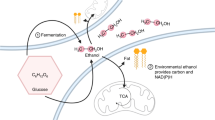Summary
Yeast mutants lacking phosphofructokinase activity because of a defect in one of the two genes PFK1 and PFK2 can still perform glycolysis and produce ethanol. However, they differ from normal wild-type yeast in several ways. After a transfer from a sugar-free to a glucose medium, wild-type cells start to produce ethanol right away, mutants only after a lag period of about 90 min. About two-thirds of the carbon atoms released as CO2 from wild-type cells derive from glucose carbon atoms 3 and 4. Mutants with a single defect in one of the two phosphofructokinase genes PFK1 and PFK2 show no such a preferential contribution of these two C-atoms of glucose. All six C-atoms contribute almost equally to CO2 production. We have isolated mutants that block glycolysis in single pfk1 and pfk2 mutants. They could be located in three different genes called BYP1, BYP2 and BYP3 (BYP for bypass). In a byp1 mutant, CO2 derived almost exclusively from C-atoms 3 and 4 of glucose. This is what the classical concept of yeast glycolysis predicts. During a search for metabolites accumulating in pfk and byp mutants, we found sedoheptulose-7-phosphate, a pentosephosphate cycle intermediate not detectable in wild-type cells. An analysis of enzymes acting in the direct oxidation of glucose-6-phosphate and in the pentosephosphate cycle did not show any defects in those activities. It is hypothesized that the pentosephosphate cycle not only functions, in providing phosphorylated derivatives of tetroses and pentoses for biosynthetic needs, but also plays an important role in sugar catabolism and fermentation. This hypothesis also implies that the reaction sequency catalyzed by phosphofructokinase and aldolase covers only part of the total catabolic flux.
Similar content being viewed by others
References
Ashwell G (1957) Colorimetric analysis of sugars. Methods in Enzymol 3:73–105
Barnett JA (1976) The utilization of sugars by yeast. Adv Carbohydr Chem Biochem 32:126–234
Bergmeyer HU (1970) Methoden der Enzymatischen Analyse, vol. 1. Verlag Chemie, Weinheim, pp 100–163
Breitenbach-Schmitt I, Heinisch J, Schmitt, HD, Zimmermann FK (1984) yeast mutants without phosphofructokinase activity can still perform glycolysis and alcoholic fermentation. Mol Gen Genet 195:530–535
Ciriacy M, Breitenbach I (1979) Physiological effects of seven different blocks in glycolysis in Saccharomyces cerevisae. J Bacteriol 139:152–160
Clifton D, Fraenkel DG (1982) Mutant studies of yeast phosphofructokinase. Biochemistry 21:1935–1942
Clifton D, Weinstock SB, Fraenkel DG (1978) Glycolysis mutants in Saccharomyces cerevisiae. Genetics 88:1–11
Hankinson D, Cove DJ (1974) Regulation of the pentose phosphate pathway in the fungus Aspergillus nidulans. J Biol Chem 249:2344–2353
Horecker BL, Rosen OM, Kowal J, Rosen S, Scher B, Lai CY, Hoffee P, Cremona T (1968) Comparative study of aldolase and fructose diphosphatases. In: Mills AK (ed) Aspects of yeast metabolism. Blackwell, Oxford Edinburgh, PP 71–105
Lagunas R, Gancedo JM (1973) Reduced pyridine nucleotides balance in glucose-growing Saccharomyces cerevisiae. Eur J Biochem 37:90–94
Lobo Z, Maitra PK (1982) Pentose phosphate pathway mutants of yeast. Mol Gen Genet 185:367–368
Lobo Z, Maitra PK (1983) Phosphofructokinase mutants of yeast. J Biol Chem 258:144–149
Novello F, McLean P (1968) The pentose phosphate pathway of glucose metabolism. Biochem J 107:775–791
Williams JF, Blackmore PF (1983) Non-oxidative synthesis of pentose-5-phosphate from hexose-6-phosphate and triose phosphate by the L-type pentose pathway. Int J Biochem 15:797–816
Williams JF, Blackmore PF, Clark MG (1978) New reaction sequences for the non-oxidative pentose phosphate pathway. Biochem J 176:257–282
Wood T (1975) Determination of sedoheptulose-7-phosphate. Methods Enzymol 41:34–36
Wood T (1979) Purification and properties of D-ribulose-5-phosphate 3-epimerase from calf liver. Biochem Biophys Acta 570:352–362
Wood T (1981) The preparation of transketolase free from Dribulose-5-phosphate 3-epimerase. Biochem Biophys Acta 659:233–243
Author information
Authors and Affiliations
Additional information
Communicated by H. Böhme
Rights and permissions
About this article
Cite this article
Breitenbach-Schmitt, I., Schmitt, H.D., Heinisch, J. et al. Genetic and physiological evidence for the existence of a second glycolytic pathway in yeast parallel to the phosphofructokinase-aldolase reaction sequence. Mol Gen Genet 195, 536–540 (1984). https://doi.org/10.1007/BF00341459
Received:
Issue Date:
DOI: https://doi.org/10.1007/BF00341459




